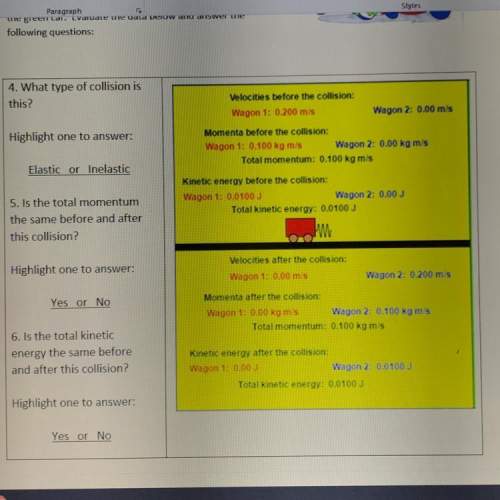4. what type of collision is
this?
velocities before the collision:
wagon 1: 0....

Physics, 12.11.2019 23:31 dlatricewilcoxp0tsdw
4. what type of collision is
this?
velocities before the collision:
wagon 1: 0.200 m/s
wagon 2: 0.00 m/s
highlight one to
momenta before the collision:
wagon 1: 0.100 kg mis wagon 2: 0.00 kg mis
total momentum: 0.100 kg mis
elastic or inelastic
kinetic energy before the collision:
wagon 1: 0.0100 j
wagon 2: 0.00
total kinetic energy: 0.0100 j
5. is the total momentum
the same before and after
this collision?
highlight one to
velocities after the collision:
wagon 1: 0.00 ms
wagon 2: 0.200 mis
yes or no
momenta after the collision:
wagon 1: 0,00 kg mis wagon 2: 0.100 kg mis
total momentum: 0.100 kg m/s
6. is the total kinetic
energy the same before
and after this collision?
kinetic energy after the collision:
wagon 1: 0.00 j
wagon 2: 0.01003
total kinetic energy: 0.0100 j
highlight one to
yes or no


Answers: 1


Another question on Physics

Physics, 21.06.2019 22:10
How would doubling the made of an object change the objects potential energy
Answers: 2

Physics, 21.06.2019 22:10
Agas is contained in a vertical, frictionless piston–cylinder device. the piston has a mass of 3.2 kg and a cross-sectional area of 35 cm2. a compressed spring above the piston exerts a force of 190 n on the piston. if the atmospheric pressure is 95 kpa, determine the pressure inside the cylinder.
Answers: 3

Physics, 21.06.2019 22:50
A23 kg log of wood begins from rest, 300 m up a sluice (a water track used to transport logs, think of it as an inclined plane with negligible friction) inclined at 20° to the horizontal. after it reaches the flat waterway at the bottom it collides elastically with a 100 kg block of wood initially at rest near the base of the incline. (a) how long does it take the 23 kg log to travel down the incline? (b) what is the speed of the 23 kg log at the bottom of the incline? (c) what are the velocities of both blocks of wood after the collision? (d) what is the total kinetic energy before the collision? (e) what is the kinetic energy of the 23 kg log after the collision? (f) what is the kinetic energy of the 100 kg block of wood after the collision? (g) what is the total kinetic energy after the collision? (h) compare the total initial and total final kinetic energies. is this consistent with what you would expect for elastic collisions? explain!
Answers: 1

Physics, 22.06.2019 08:30
Pl asaaap ! match the term to the correct description. a type of wave that transfers energy where the particles in the medium move perpendicular to the direction in which the energy is traveling. a type of wave that transfers energy where the particles in the medium move parallel to the direction in which the energy is traveling. movement that is back and forth, like an equal sign = a type of wave that transfers energy where the particles in the medium move in a circle motion while the energy travels left or right. movement that is like a t transfers energy from one location to another 1. wave 2. parallel movement 3. perpendicular movement 4. transverse wave 5. longitudinal wave 6. surface wave
Answers: 1
You know the right answer?
Questions


History, 06.11.2019 09:31



English, 06.11.2019 09:31


English, 06.11.2019 09:31


Chemistry, 06.11.2019 09:31

History, 06.11.2019 09:31

English, 06.11.2019 09:31

Physics, 06.11.2019 09:31

Mathematics, 06.11.2019 09:31


Chemistry, 06.11.2019 09:31



Physics, 06.11.2019 09:31


History, 06.11.2019 09:31



